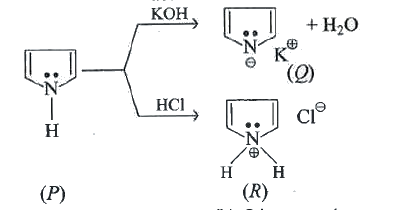Which is true about the electronegative order of the following elements ?
P>Si
C>N
Br>Cl
Sr>Ga
The correct Answer is:A
To determine the correct order of electronegativity among the given elements, we need to understand the trends in electronegativity across periods and down groups in the periodic table. Here’s a step-by-step solution:
Step 1: Understand Electronegativity Trends
Electronegativity is the ability of an atom to attract electrons in a chemical bond. The general trends are:
- Across a Period (Left to Right): Electronegativity increases because the atomic size decreases and the effective nuclear charge increases.
- Down a Group (Top to Bottom): Electronegativity decreases because the atomic size increases, making it harder for the nucleus to attract bonding electrons.
Step 2: Analyze the Given Elements
We will analyze the electronegativity of the following pairs of elements based on their positions in the periodic table:
1. Phosphorus (P) and Silicon (Si)
2. Carbon (C) and Nitrogen (N)
3. Bromine (Br) and Chlorine (Cl)
4. Strontium (Sr) and Gallium (Ga)
Step 3: Compare Electronegativity of Each Pair
1. Phosphorus (P) vs. Silicon (Si):
- Silicon is to the left of phosphorus in the periodic table.
- Therefore, P > Si (Phosphorus is more electronegative than Silicon).
2. Carbon (C) vs. Nitrogen (N):
- Nitrogen is to the right of carbon in the periodic table.
- Therefore, N > C (Nitrogen is more electronegative than Carbon).
3. Bromine (Br) vs. Chlorine (Cl):
- Chlorine is above bromine in the periodic table.
- Therefore, Cl > Br (Chlorine is more electronegative than Bromine).
4. Strontium (Sr) vs. Gallium (Ga):
- Gallium is to the right of strontium in the periodic table.
- Therefore, Ga > Sr (Gallium is more electronegative than Strontium).
Step 4: Conclusion
Based on the analysis, the correct order of electronegativity for the pairs is:
- P > Si
- N > C
- Cl > Br
- Ga > Sr
Thus, the only correct statement regarding electronegativity is that phosphorus is more electronegative than silicon.
Final Answer
The correct order of electronegativity is:
- Phosphorus (P) > Silicon (Si)
Electronegativity is the ability of an atom to attract electrons in a chemical bond. The general trends are:
- Across a Period (Left to Right): Electronegativity increases because the atomic size decreases and the effective nuclear charge increases.
- Down a Group (Top to Bottom): Electronegativity decreases because the atomic size increases, making it harder for the nucleus to attract bonding electrons.
We will analyze the electronegativity of the following pairs of elements based on their positions in the periodic table:
1. Phosphorus (P) and Silicon (Si)
2. Carbon (C) and Nitrogen (N)
3. Bromine (Br) and Chlorine (Cl)
4. Strontium (Sr) and Gallium (Ga)
1. Phosphorus (P) vs. Silicon (Si):
- Silicon is to the left of phosphorus in the periodic table.
- Therefore, P > Si (Phosphorus is more electronegative than Silicon).
- Nitrogen is to the right of carbon in the periodic table.
- Therefore, N > C (Nitrogen is more electronegative than Carbon).
- Chlorine is above bromine in the periodic table.
- Therefore, Cl > Br (Chlorine is more electronegative than Bromine).
- Gallium is to the right of strontium in the periodic table.
- Therefore, Ga > Sr (Gallium is more electronegative than Strontium).
Based on the analysis, the correct order of electronegativity for the pairs is:
- P > Si
- N > C
- Cl > Br
- Ga > Sr
The correct order of electronegativity is:
- Phosphorus (P) > Silicon (Si)
Topper's Solved these Questions
- PERIODIC CLASSIFICATION OF ELEMENTS AND GENERAL INORGANIC CHEMISTRYBook:CENGAGE CHEMISTRY ENGLISHChapter:PERIODIC CLASSIFICATION OF ELEMENTS AND GENERAL INORGANIC CHEMISTRYExercise:Exercises (Single Correct) Acidic, Basicand Amphoteric Character
Explore 11 Videos
- PERIODIC CLASSIFICATION OF ELEMENTS AND GENERAL INORGANIC CHEMISTRYBook:CENGAGE CHEMISTRY ENGLISHChapter:PERIODIC CLASSIFICATION OF ELEMENTS AND GENERAL INORGANIC CHEMISTRYExercise:Exercises (Single Correct) Bond Angle
Explore 4 Videos
- PERIODIC CLASSIFICATION OF ELEMENTS AND GENERAL INORGANIC CHEMISTRYBook:CENGAGE CHEMISTRY ENGLISHChapter:PERIODIC CLASSIFICATION OF ELEMENTS AND GENERAL INORGANIC CHEMISTRYExercise:Exercises (Single Correct) Matallic-Non Metallic Character
Explore 3 Videos
- P-BLOCK GROUP 14 - CARBON FAMILYBook:CENGAGE CHEMISTRY ENGLISHChapter:P-BLOCK GROUP 14 - CARBON FAMILYExercise:Exercises Archives (Subjective)
Explore 9 Videos
- PURIFICATION OF ORGANIC COMPOUNDS AND QUALITATIVE AND QUANTITATIVE ANALYSISBook:CENGAGE CHEMISTRY ENGLISHChapter:PURIFICATION OF ORGANIC COMPOUNDS AND QUALITATIVE AND QUANTITATIVE ANALYSISExercise:Assertion Reasoning Type
Explore 5 Videos
Similar Questions
Knowledge Check
Which is not true about the oxidation state of the following elements ?
ASulphur +6 to -2BCarbon +4 to -4CChlorine +7 to -1DNitrogen +3 to -1Which is true about following reactions ?
 AP is aromaticBQ is aromaticCR is antiaromaticDR is non-aromatic
AP is aromaticBQ is aromaticCR is antiaromaticDR is non-aromaticThe most electronegative element is
ASodiumBAluminiumCBromineDFluorine
The electronegativity of the following elements increases in the order:
View SolutionThe increasing order of electronegativity in the following elements :
View SolutionThe correct order of increasing electronegativity of the following elements is:
View SolutionThe correct order of increasing electronegativity of the following elements is:
View SolutionThe electronegativity follows the order
View Solution